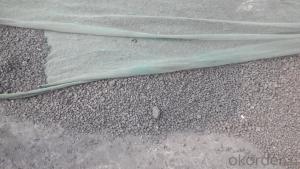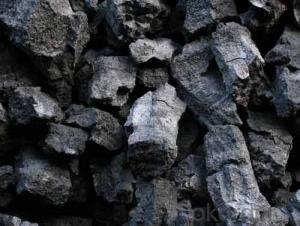MET COKE of Coke Strength after Reactivity 62
- Loading Port:
- Tianjin
- Payment Terms:
- TT OR LC
- Min Order Qty:
- 100 m.t.
- Supply Capability:
- 3000 m.t./month
OKorder Service Pledge
OKorder Financial Service
You Might Also Like
We export many kinds of coke, such as CSR64 % and CSR 62% metallurgical coke (met coke), the NUT coke of 20 to 50 mm, coke breeze of 3 to 6 mm, and so on.
We can offer below grade met coke, origin from China.
Parameters | Guarantee |
Moisture (ARB) | 5% max |
Ash (DB) | 12.50% max |
Volatile Matter (DB) | 1.4% max |
Sulphur (DB) | 0.7% max |
Phosphorus (DB) | 0.035% max |
CSR | 62% min |
CRI | 28% max |
M40 | 82% min |
M10 | 8% max |
Size 30-90 mm – 90% min | ON SQUARE MESH SCREEN |
+90 mm | 5% max |
-30mm | 5% max |
Mean Size | 52 mm |
At present, the main customers are NOBLE GROUP, IMR and so on. Our main overseas markets are Japan, India, Brazil, Iran, Vietnam, and so on.
Should any of these items be of interest to you, please let us know. We will be happy to give you a quotation upon receipt of your detailed requirements.
- Q: What is the use of petroleum coke
- According to the quality can be divided into two kinds of primary and qualified products. Qualified products are divided into six grades. Used in the manufacture of electrodes, calcium carbide, corundum and so on and used as a filling tank, also used as insulating materials and fuel, etc..
- Q: How to calculate the average particle size of coke
- That is, "(volume) of the table of the percentage, in addition to the corresponding boundary value", these values are added, then the countdown. For example, the boundary 0 to 1 has a value of 10%, between 1 and 2, and between 2 and 4 has a value of 40%, and between 4 and 8, then D (3,2) = / (0.1/0.5 + 0.3/1.5 + 0.4/3 + 0.2/6) = 1/ (+ + 0.2 + + + 0.13 + +) = 1/0.56 = = =
- Q: Coke indicators are divided into grades
- The index of pore structure is mainly expressed by the porosity rate (the percentage of the total volume of coke), which affects the reactivity and strength of coke. Different uses of different coke porosity index requirements, the general requirements of metallurgical coke porosity in the 40 ~ 45%, 35 ~ 40% in coke, coke export demand in about 30%. Coke crack degree and the porosity level, and the coking coal has a direct relationship, such as coal based coke refining, crack, high porosity, low strength; with coal as the foundation of the coal refining coke crack less, low porosity and high strength
- Q: Why is coke used in blast furnace steelmaking?Why not use coal?
- The role of coke in blast furnace steelmaking is as follows:(1) providing heat: the coke burns fiercely in the raceway in front of the tuyere of the coke oven, and the heat generated by the combustion is the main heat source in the process of blast furnace smelting.
- Q: I don't understand. With coke, then the rest of the coke, they are selling it?
- If most of the solid fuel is burning coal, but coking coal, which is very strong viscosity of coal is not good, it is very interesting to use the individual plant with it, the purpose is to change the fuel characteristics.Coking coal and coke, commonly used in metallurgical industry.Coal will be heated to a process of coke, but you really want to get coke, to specialized production. Power plants do not produce coke, they only have gray coke
- Q: I see that there are metallurgical coke and coke on the Internet, what is the difference between them (I hope to be able to say in detail) and a level of two points, how is this going on?.. Where is the quality of coke in China? Hunan good coke plant which? Although the problem is a little bit more, I hope that insiders can give some useful information. Extremely grateful.
- Coke is a special and molten iron cupola coke. Coke is the main fuel cupola molten iron. Its role is to melt the burden and make the hot metal overheating, the support column to maintain good ventilation. Therefore, the foundry coke should have large blocks, low reactivity, porosity is small, with impact crushing strength, low ash and sulfur enough
- Q: 8 points will be isolated from the air to enhance the heat of coal, in addition to the main coke, but also the material listed in the following table: No.
- Ethylene containing carbon carbon double bonds can react with bromine and bromine, and reaction of bleaching, b.:
- Q: What is coke? What is the use?
- In addition to coke for iron and non-ferrous metal smelting (metallurgical coke), but also for casting, chemical, calcium carbide and iron alloy, its quality requirements vary. Such as foundry coke, generally require large size, low porosity, high fixed carbon and low sulfur; chemical gasification, strict requirements for strength. But requires good response, high ash melting point; calcium carbide and coke production requirements to improve the fixed carbon content.
- Q: How to determine the maturity of coke or not?
- The sulfur content of coke: refers to the percentage of sulfur content in coke. Sulfur is one of the harmful impurities in pig iron smelting. The sulfur content in the pig iron is more than 0.07%. 82.5% of the sulfur from blast furnace charge into the furnace comes from coke, so coke is the main source of sulfur. Sulfur content in coke directly affects the production of blast furnace. When the sulfur content in coke is greater than 1.6%, sulfur increased 0.1%, the amount of coke increased 1.8%, limestone amount increased by 3.7%, with the increasing of the amount of ore 0.3%, blast furnace production decreased 1.5 - 2%.
- Q: The two day of the fire is not wang you have a good way to have any good way. Such online
- If you are at the barbecue, with the leaves, the leaves on the carbon below, with a stick carbon increase, the ignition, a side side to add some minor burns carbon. If the technology is good, probably a few minutes. If there is no dry leaves to replace paper.
Send your message to us
MET COKE of Coke Strength after Reactivity 62
- Loading Port:
- Tianjin
- Payment Terms:
- TT OR LC
- Min Order Qty:
- 100 m.t.
- Supply Capability:
- 3000 m.t./month
OKorder Service Pledge
OKorder Financial Service
Similar products
Hot products
Hot Searches























